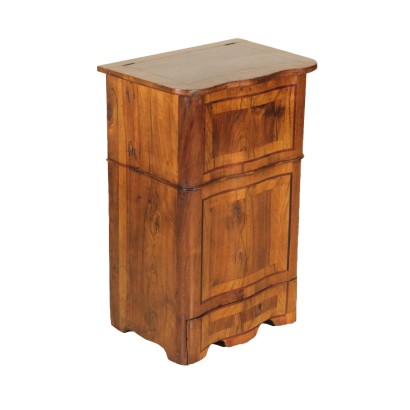Comfortable Venetian
Features
Age: 18th Century / 1701 - 1800
Year: Metà '700
Origin: Veneto, Italy
Main essence: Amaranth , Walnut , Olive
Material: Walnut Slab , Walnut Feather Banded
Description
Comfortable from the front moved presents drawer concealed in the band and the openable top flap that allows the opening of the upper part for access to the location. Reserves in feather of walnut borders, olive and amaranth.
Product Condition:
Product that shows signs of wear due to age. Requires small restoration interventions.
Dimensions (cm):
Height: 85,4
Width: 54
Depth: 40
Additional Information
Age: 18th Century / 1701 - 1800
18th Century / 1701 - 1800 Main essence:
Amaranth
It is a very hard wood, coming from Guiana and Latin America in general. Very valuable, it is also known as "purple wood" because it has a very reddish color when it is cut, but when it is seasoned it changes to a crimson hue. Widely used by French cabinetmakers, especially in inlays, often combined with bois de rose, and sometimes as a veneer.
Walnut
Walnut wood comes from the plant whose botanical name is juglans regia , probably originally from the East but very common in Europe. Light or dark brown in color, it is a hard wood with a beautiful grain, widely used in antique furniture. It was the main essence in Italy throughout the Renaissance and later had a good diffusion in Europe, especially in England, until the advent of mahogany. It was used for solid wood furniture and sometimes carvings and inlays, its only big limitation is that it suffers a lot from woodworm. In France it was widely used more than anything else in the provinces. In the second half of the eighteenth century its use decreased significantly because mahogany and other exotic woods were preferred.
Olive
Extracted from the plant called olea europaea which lives in all the Mediterranean lands, it is a hard and compact wood. It has a characteristic light color, greenish yellow, with particular dark veins. It is widely used in cabinet making both as a solid wood for entire furniture, and for inlays, veneers and decorations. As it is very hard, it is also suitable for round work and for the manufacture of small objects. Material:
Walnut Slab
Walnut Feather Banded


























